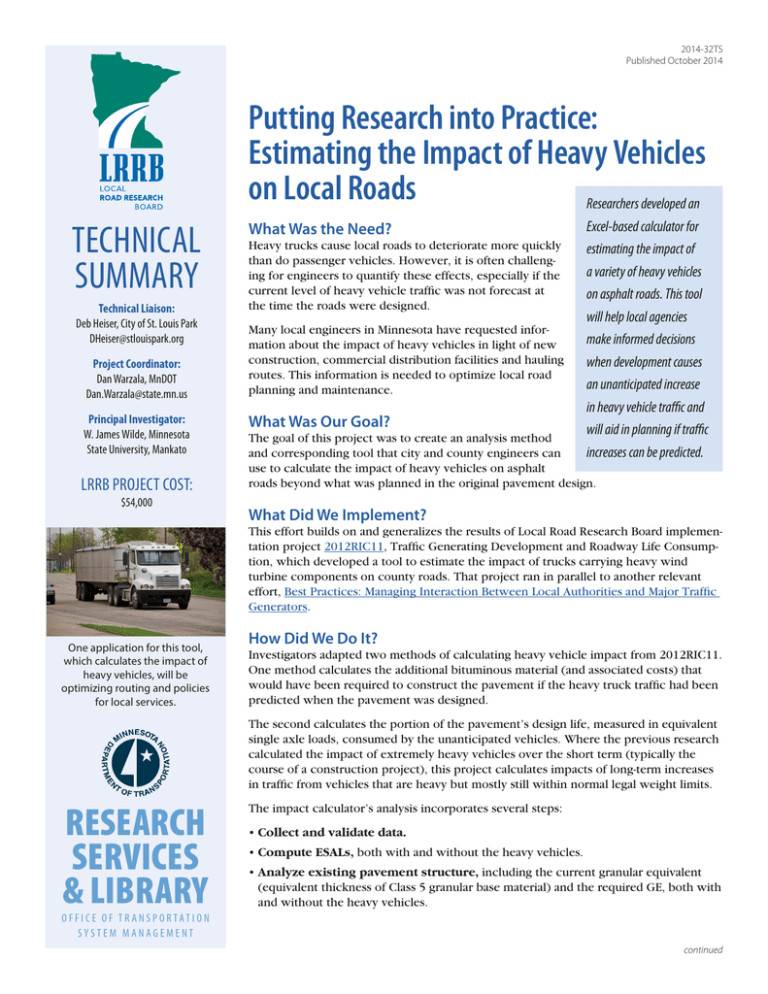TECHNICAL SUMMARY Putting Research into Practice: Estimating the Impact of Heavy Vehicles
advertisement

2014-32TS Published October 2014 Putting Research into Practice: Estimating the Impact of Heavy Vehicles on Local Roads Researchers developed an TECHNICAL SUMMARY Technical Liaison: Deb Heiser, City of St. Louis Park DHeiser@stlouispark.org Project Coordinator: Dan Warzala, MnDOT Dan.Warzala@state.mn.us Principal Investigator: W. James Wilde, Minnesota State University, Mankato LRRB PROJECT COST: $54,000 What Was the Need? Heavy trucks cause local roads to deteriorate more quickly than do passenger vehicles. However, it is often challenging for engineers to quantify these effects, especially if the current level of heavy vehicle traffic was not forecast at the time the roads were designed. Many local engineers in Minnesota have requested information about the impact of heavy vehicles in light of new construction, commercial distribution facilities and hauling routes. This information is needed to optimize local road planning and maintenance. What Was Our Goal? Excel-based calculator for estimating the impact of a variety of heavy vehicles on asphalt roads. This tool will help local agencies make informed decisions when development causes an unanticipated increase in heavy vehicle traffic and will aid in planning if traffic increases can be predicted. The goal of this project was to create an analysis method and corresponding tool that city and county engineers can use to calculate the impact of heavy vehicles on asphalt roads beyond what was planned in the original pavement design. What Did We Implement? This effort builds on and generalizes the results of Local Road Research Board implementation project 2012RIC11, Traffic Generating Development and Roadway Life Consumption, which developed a tool to estimate the impact of trucks carrying heavy wind turbine components on county roads. That project ran in parallel to another relevant effort, Best Practices: Managing Interaction Between Local Authorities and Major Traffic Generators. One application for this tool, which calculates the impact of heavy vehicles, will be optimizing routing and policies for local services. How Did We Do It? Investigators adapted two methods of calculating heavy vehicle impact from 2012RIC11. One method calculates the additional bituminous material (and associated costs) that would have been required to construct the pavement if the heavy truck traffic had been predicted when the pavement was designed. The second calculates the portion of the pavement’s design life, measured in equivalent single axle loads, consumed by the unanticipated vehicles. Where the previous research calculated the impact of extremely heavy vehicles over the short term (typically the course of a construction project), this project calculates impacts of long-term increases in traffic from vehicles that are heavy but mostly still within normal legal weight limits. RESEARCH SERVICES & LIBRARY The impact calculator’s analysis incorporates several steps: • Collect and validate data. • Compute ESALs, both with and without the heavy vehicles. • Analyze existing pavement structure, including the current granular equivalent (equivalent thickness of Class 5 granular base material) and the required GE, both with and without the heavy vehicles. O FFICE O F TR ANSP O R TATI O N SYSTEM MANAGEMENT continued “One analysis method for the impact of unexpected heavy vehicles essentially designs the road twice, both with and without those vehicles. The difference in design costs represents the impact of the heavy vehicles.” —W. James Wilde, Professor, Minnesota State University, Mankato, Department of Mechanical & Civil Engineering While heavy vehicles from developments such as distribution centers often carry loads that are legal for local roads, the volume of traffic still has a major impact on road life. Local officials can use the tool developed in this project to calculate that impact and make informed maintenance decisions. • Estimate impacts, including the additional bituminous material required, the pavement life consumed and the degradation in pavement performance caused by the specified heavy vehicles. • Compute quantities and costs of additional bituminous material needed or lost pavement life. • Report results. “Before this project, there wasn’t an easy way for an engineer to determine how much a specific truck is going to decrease the life of a road.” —Deb Heiser, Engineering Director, City of St. Louis Park What Was the Impact? The impact calculator is a Microsoft Excel document that accepts data about pavement design, costs and condition imported from a pavement management system or entered manually. A variety of heavy vehicle scenarios are built into the tool, with variations that represent full, empty or half-full vehicles, so engineers can easily calculate vehicle impact. Users can also define custom vehicle parameters based on the number of axle groups, axle configurations and axle group weights. The tool can calculate the impact of up to nine vehicle types simultaneously. The tool can be used to conduct analyses for a single street segment or an entire road network. It reports impacts of heavy vehicles both in financial terms and as the quantity of ESALs consumed or additional bituminous material required. Users can also compare current situations with proposed ones to evaluate the impact of potential changes in heavy traffic levels. What’s Next? The tool is ready for use and will be made available on LRRB’s website to help local agencies evaluate their road networks and traffic levels to make informed decisions. The information will allow agencies to plan roads for anticipated developments and redesign roads near the end of their service life to handle existing conditions. Agencies may also be able to use it to optimize services with minimal damage to roads, such as by determining the relative costs of organized (municipally coordinated) and open (customerselected) waste collection. Produced by CTC & Associates for: Minnesota Department of Transportation Research Services & Library MS 330, First Floor 395 John Ireland Blvd. St. Paul, MN 55155-1899 651-366-3780 www.mndot.gov/research Unlike 2012RIC11, this tool will not necessarily allow agencies to assess costs that can be billed to the sources of the heavy traffic, since the loads being analyzed are generally within legal weight limits. If agencies hope to use the tool to recover costs, the legal aspects of this kind of cost assessment would likely need to be evaluated. Potential additional functionality includes providing analysis for concrete pavements; incorporating mechanistic-empirical design and other design methods as they are implemented; and creating improved definitions for vehicle types and axle loads for full, empty and half-full modes. This Technical Summary pertains to the LRRB-produced Report 2014-32, “Assessing the Effects of Heavy Vehicles on Local Roadways,” published August 2014. The full report can be accessed at http://www.lrrb.org/PDF/201432.pdf.





